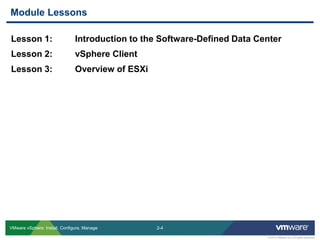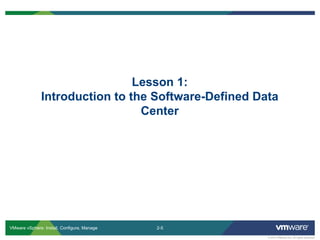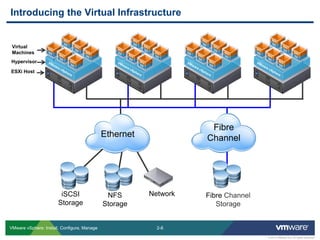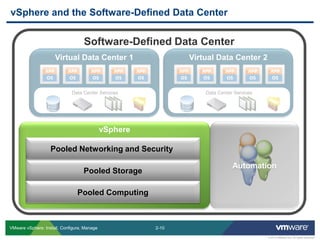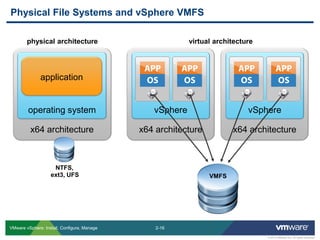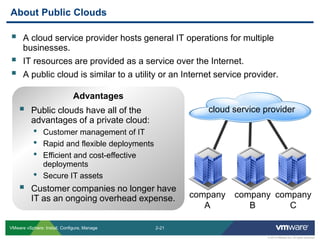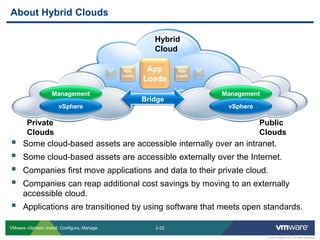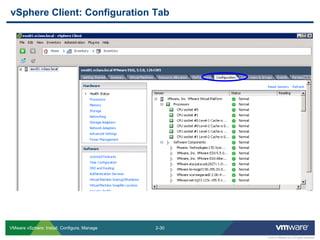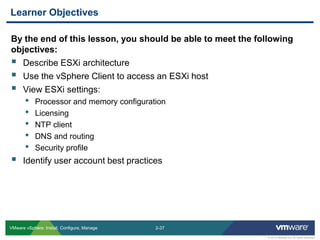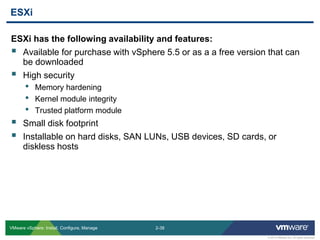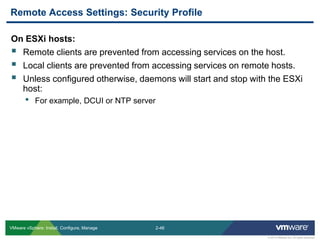VMware
- 1. © 2013 VMware Inc. All rights reserved Software-Defined Data Center Module 2
- 2. 2-2 © 2013 VMware Inc. All rights reserved VMware vSphere: Install, Configure, Manage Course Introduction Software-Defined Data Center Creating Virtual Machines VMware vCenter Server Configuring and Managing Virtual Networks Configuring and Managing Virtual Storage Virtual Machine Management Access and Authentication Control Resource Management and Monitoring High Availability and Fault Tolerance Host Scalability Patch Management Installing vSphere Components You Are Here
- 3. 2-3 © 2013 VMware Inc. All rights reserved VMware vSphere: Install, Configure, Manage VMware vSphere® software suite is based on many components with which a vSphere administrator should be familiar. You must understand the following vSphere concepts and best practices: The basic concept of virtualization, VMware ESXi™, and the virtual machine The fundamental vSphere components and how vSphere can be used in your software-defined data center How the VMware vSphere® Client™ and VMware vSphere® Web Client are used to administrate and manage vSphere environments Importance
- 4. 2-4 © 2013 VMware Inc. All rights reserved VMware vSphere: Install, Configure, Manage Lesson 1: Introduction to the Software-Defined Data Center Lesson 2: vSphere Client Lesson 3: Overview of ESXi Module Lessons
- 5. 2-5 © 2013 VMware Inc. All rights reserved VMware vSphere: Install, Configure, Manage Lesson 1: Introduction to the Software-Defined Data Center
- 6. 2-6 © 2013 VMware Inc. All rights reserved VMware vSphere: Install, Configure, Manage By the end of this lesson, you should be able to meet the following objectives: Compare and contrast physical and virtual architectures Describe the benefits of using virtual machines Describe how vSphere interacts with CPUs, memory, networks, and disks Describe how vSphere fits into the cloud and the software-defined data center Learner Objectives
- 7. 2-7 © 2013 VMware Inc. All rights reserved VMware vSphere: Install, Configure, Manage Data Center Physical Infrastructure Fibre Channel Storage Fibre Channel Ethernet NFS Storage iSCSI Storage Network Applications Operating System Physical Host
- 8. 2-8 © 2013 VMware Inc. All rights reserved VMware vSphere: Install, Configure, Manage Introducing the Virtual Infrastructure Hypervisor ESXi Host Fibre Channel Fibre Channel Storage Ethernet NFS Storage iSCSI Storage Network Virtual Machines
- 9. 2-9 © 2013 VMware Inc. All rights reserved VMware vSphere: Install, Configure, Manage Physical and Virtual Architecture virtual architecture x64 architecture vSphere physical architecture x64 architecture operating system application
- 10. 2-10 © 2013 VMware Inc. All rights reserved VMware vSphere: Install, Configure, Manage Software-Defined Data Center vSphere and the Software-Defined Data Center vSphere Pooled Storage Pooled Computing Pooled Networking and Security Automation Virtual Data Center 2 Data Center Services Virtual Data Center 1 Data Center Services
- 11. 2-11 © 2013 VMware Inc. All rights reserved VMware vSphere: Install, Configure, Manage Reasons to Use Virtual Machines Easy to relocate: Encapsulated into files Independent of physical hardware Easy to manage: Isolated from other virtual machines Insulated from hardware changes Provides the ability to support legacy applications Allows servers to be consolidated Virtual machine Physical machine Difficult to relocate: Moves require downtime Specific to physical hardware Difficult to manage: Requires physical maintenance Hardware failures cause downtime Hardware has limitations: Hardware changes limit application support Servers are physically individual
- 12. 2-12 © 2013 VMware Inc. All rights reserved VMware vSphere: Install, Configure, Manage Resource Sharing vSphere x64 architecture
- 13. 2-13 © 2013 VMware Inc. All rights reserved VMware vSphere: Install, Configure, Manage x64 architecture operating system application CPU Virtualization virtual architecture x64 architecture vSphere physical architecture
- 14. 2-14 © 2013 VMware Inc. All rights reserved VMware vSphere: Install, Configure, Manage Physical and Virtualized Host Memory Usage physical architecture virtual architecture x64 architecture operating system x64 architecture vSphere application 1GB 2GB 8GB
- 15. 2-15 © 2013 VMware Inc. All rights reserved VMware vSphere: Install, Configure, Manage Physical and Virtual Networking virtual architecture vSphere physical architecture x64 architecture operating system application virtual switch x64 architecture
- 16. 2-16 © 2013 VMware Inc. All rights reserved VMware vSphere: Install, Configure, Manage Physical File Systems and vSphere VMFS physical architecture virtual architecture x64 architecture operating system application x64 architecture vSphere x64 architecture vSphere NTFS, ext3, UFS VMFS
- 17. 2-17 © 2013 VMware Inc. All rights reserved VMware vSphere: Install, Configure, Manage Encapsulation VM 1 VM 2 VM 3 Datastore (VMware vSphere® VMFS or NFS)
- 18. 2-18 © 2013 VMware Inc. All rights reserved VMware vSphere: Install, Configure, Manage VMFS Linux/UNIX Windows File-System Layouts C: D: E: / usr etc opt / vmfs Local VM 1 VM 2 VM 3 VM 4 SAN volumes
- 19. 2-19 © 2013 VMware Inc. All rights reserved VMware vSphere: Install, Configure, Manage hybrid cloud Installing vSphere creates a virtual infrastructure. Your virtual machines run in this virtual infrastructure. VMware® vCloud Director® enables you to create a cloud. Third-party providers can host public or private clouds. VMware® clouds empower you to run your virtual machines in a private, public, or hybrid cloud to fit your business needs. How vSphere Fits into Cloud Computing private cloud public cloud
- 20. 2-20 © 2013 VMware Inc. All rights reserved VMware vSphere: Install, Configure, Manage Individual departments or internal corporate organizations (divisions) are able to deploy and manage IT infrastructure through virtual systems as needed. IT capabilities are provided as a service, over an intranet, in the enterprise, and behind the firewall. About Private Clouds Gizmo division Widget division Human Resources Sales enterprise private cloud Internet Advantages Self-service provisioning Elasticity of resources Rapid and simplified provisioning Secured multitenancy Improved use of IT resources Better control of IT budgets
- 21. 2-21 © 2013 VMware Inc. All rights reserved VMware vSphere: Install, Configure, Manage Advantages A cloud service provider hosts general IT operations for multiple businesses. IT resources are provided as a service over the Internet. A public cloud is similar to a utility or an Internet service provider. About Public Clouds company A company B cloud service provider company C Public clouds have all of the advantages of a private cloud: •Customer management of IT •Rapid and flexible deployments •Efficient and cost-effective deployments •Secure IT assets Customer companies no longer have IT as an ongoing overhead expense.
- 22. 2-22 © 2013 VMware Inc. All rights reserved VMware vSphere: Install, Configure, Manage Some cloud-based assets are accessible internally over an intranet. Some cloud-based assets are accessible externally over the Internet. Companies first move applications and data to their private cloud. Companies can reap additional cost savings by moving to an externally accessible cloud. Applications are transitioned by using software that meets open standards. About Hybrid Clouds App Loads App Loads App Loads Hybrid Cloud Private Clouds Public Clouds Bridge Management Management vSphere vSphere
- 23. 2-23 © 2013 VMware Inc. All rights reserved VMware vSphere: Install, Configure, Manage VMware Complete Cloud Infrastructure & Management Suite Management and Automation Network / Security Compute vCloud Automation Center vCenter Operations Management Suite IT Business Management Suite NSX vCloud Networking and Security Storage / Availability Virtual SAN vCenter Site Recovery Manager vCenter Server and vCloud Director vSphere
- 24. 2-24 © 2013 VMware Inc. All rights reserved VMware vSphere: Install, Configure, Manage You should be able to meet the following objectives: Compare and contrast physical and virtual architectures Describe the benefits of using virtual machines Describe how vSphere interacts with CPUs, memory, networks, and disks Describe how vSphere fits into the cloud and the software-defined data center Review of Learner Objectives
- 25. 2-25 © 2013 VMware Inc. All rights reserved VMware vSphere: Install, Configure, Manage Lesson 2: vSphere Client
- 26. 2-26 © 2013 VMware Inc. All rights reserved VMware vSphere: Install, Configure, Manage By the end of this lesson, you should be able to meet the following objectives: Identify the user interfaces used with ESXi and VMware® vCenter™ Download and install the vSphere Client Describe the navigation panes in the vSphere Client Learner Objectives
- 27. 2-27 © 2013 VMware Inc. All rights reserved VMware vSphere: Install, Configure, Manage User Interfaces vSphere Client vSphere Web Client ESXi host your desktop vCenter Server
- 28. 2-28 © 2013 VMware Inc. All rights reserved VMware vSphere: Install, Configure, Manage vSphere Client is an interface that you use to connect remotely to VMware® vCenter Server™ or an ESXi host from a Windows system. To download the vSphere Client: Use the VMware vCenter Server Installer. Download the client from the vCenter Server system or an ESXi host. •Internet access is required. Downloading vSphere Client Download the vSphere Client to a supported Windows system. Point to the vCenter Server or ESXi host.
- 29. 2-29 © 2013 VMware Inc. All rights reserved VMware vSphere: Install, Configure, Manage In the vSphere Client login window, enter the following: Host name or IP address of ESXi host or vCenter Server User name Password for that user (Optional) Use your Windows session credentials. Using vSphere Client
- 30. 2-30 © 2013 VMware Inc. All rights reserved VMware vSphere: Install, Configure, Manage vSphere Client: Configuration Tab
- 31. 2-31 © 2013 VMware Inc. All rights reserved VMware vSphere: Install, Configure, Manage Viewing Processor and Memory Configuration
- 32. 2-32 © 2013 VMware Inc. All rights reserved VMware vSphere: Install, Configure, Manage Use vSphere Client to view logs. Viewing ESXi System Logs Export system logs to an archive file: Send to VMware support.
- 33. 2-33 © 2013 VMware Inc. All rights reserved VMware vSphere: Install, Configure, Manage Viewing Licensed Features XXXXX-XXXXX-XXXXX-XXXXX
- 34. 2-34 © 2013 VMware Inc. All rights reserved VMware vSphere: Install, Configure, Manage Install student desktop components 1.Access Your Student Desktop System 2.Install the vSphere Client Lab 1: Installing VMware vSphere GUIs
- 35. 2-35 © 2013 VMware Inc. All rights reserved VMware vSphere: Install, Configure, Manage You should be able to meet the following objectives: Identify the user interfaces used with ESXi and VMware® vCenter™ Download and install the vSphere Client Describe the navigation panes in the vSphere Client Review of Learner Objectives
- 36. 2-36 © 2013 VMware Inc. All rights reserved VMware vSphere: Install, Configure, Manage Lesson 3: Overview of ESXi
- 37. 2-37 © 2013 VMware Inc. All rights reserved VMware vSphere: Install, Configure, Manage By the end of this lesson, you should be able to meet the following objectives: Describe ESXi architecture Use the vSphere Client to access an ESXi host View ESXi settings: •Processor and memory configuration •Licensing •NTP client •DNS and routing •Security profile Identify user account best practices Learner Objectives
- 38. 2-38 © 2013 VMware Inc. All rights reserved VMware vSphere: Install, Configure, Manage ESXi has the following availability and features: Available for purchase with vSphere 5.5 or as a a free version that can be downloaded High security •Memory hardening •Kernel module integrity •Trusted platform module Small disk footprint Installable on hard disks, SAN LUNs, USB devices, SD cards, or diskless hosts ESXi
- 39. 2-39 © 2013 VMware Inc. All rights reserved VMware vSphere: Install, Configure, Manage Physical and Virtual Architecture VMware hypervisor – VMkernel VMM VMM VMM VMM VMM Web Client vCenter Server vSphere Client vCLI (scripting) vSphere API/DSK CIM (hardware mgmt)
- 40. 2-40 © 2013 VMware Inc. All rights reserved VMware vSphere: Install, Configure, Manage The direct console user interface (DCUI) is similar to the BIOS of a computer with a keyboard-only user interface. Configuring ESXi
- 41. 2-41 © 2013 VMware Inc. All rights reserved VMware vSphere: Install, Configure, Manage The DCUI allows an administrator to do the following: Set a root password (complex passwords only). Enable or disable lockdown mode: •Limits host management to vCenter Server and user root access to DCUI only Configuring ESXi: root Access
- 42. 2-42 © 2013 VMware Inc. All rights reserved VMware vSphere: Install, Configure, Manage The DCUI allows you to modify network settings: Host name IP configuration (IP address, subnet mask, default gateway) DNS servers Configuring ESXi: Management Network
- 43. 2-43 © 2013 VMware Inc. All rights reserved VMware vSphere: Install, Configure, Manage The DCUI allows an administrator to do the following: Configure keyboard layout. View support information. View system logs. Enable troubleshooting services, when required. Configuring ESXi: Other Settings
- 44. 2-44 © 2013 VMware Inc. All rights reserved VMware vSphere: Install, Configure, Manage Network Time Protocol (NTP) is a client-server protocol used to synchronize a computer’s clock to a time reference. NTP is important: For accurate performance graphs For accurate time stamps in log messages So that virtual machines have a source to synchronize with An ESXi host can be configured as an NTP client. It can synchronize time with an NTP server on the Internet or your corporate NTP server. ESXi as an NTP Client NTP server NTP client NTP server NTP server ESXi host NTP client uses UDP over port 123 to communicate with NTP server.
- 45. 2-45 © 2013 VMware Inc. All rights reserved VMware vSphere: Install, Configure, Manage The DNS and Routing link enables you to apply these settings: Host name and domain DNS server addresses and search domains Default VMkernel gateway Network Settings: DNS and Routing
- 46. 2-46 © 2013 VMware Inc. All rights reserved VMware vSphere: Install, Configure, Manage On ESXi hosts: Remote clients are prevented from accessing services on the host. Local clients are prevented from accessing services on remote hosts. Unless configured otherwise, daemons will start and stop with the ESXi host: •For example, DCUI or NTP server Remote Access Settings: Security Profile
- 47. 2-47 © 2013 VMware Inc. All rights reserved VMware vSphere: Install, Configure, Manage You should implement the following user account best practices: Strictly control root privileges to the ESXi host. Use the vSphere Client to manage the ESXi host. Ideally, use vCenter Server – and thus vCenter Server user accounts – to manage hosts. ESXi User Account Best Practices
- 48. 2-48 © 2013 VMware Inc. All rights reserved VMware vSphere: Install, Configure, Manage Configure an ESXi host 1.Connect to an ESXi Host with the vSphere Client 2.View the Host Hardware Configuration 3.Configure the DNS and Routing Information for an ESXi Host 4.Configure an ESXi Host as an NTP Client 5.Configure an ESXi Host to Use the Directory Services Lab 2: Configuring VMware ESXi
- 49. 2-49 © 2013 VMware Inc. All rights reserved VMware vSphere: Install, Configure, Manage You should be able to meet the following objectives: Describe ESXi architecture Use the vSphere Client to access an ESXi host View ESXi settings: •Processor and memory configuration •Licensing •NTP client •DNS and routing •Security profile Identify user account best practices Review of Learner Objectives
- 50. 2-50 © 2013 VMware Inc. All rights reserved VMware vSphere: Install, Configure, Manage Using virtual machines solves many data center problems. Virtual machines are hardware independent. Virtual machines share the physical resources of the ESXi host on which they reside. A virtual machine is a set of files that are easy to transfer and back up. Virtual machine files are encapsulated into a folder and placed on a datastore. ESXi runs directly on the host. vSphere abstracts CPU, memory, storage, and networking for virtual machine use. Questions? Key Points



